The Grumman F-14, the world’s premier air defense fighter, was designed to replace the F-4 Phantom II fighter (phased out in 1986). F-14’s provided air cover for the joint strike on Libyan terrorist related targets in 1986. The F-14A was introduced in the mid 1970s.
The F-14 is a supersonic, twin-engine, variable sweep wing, two place fighter, designed to attack and destroy enemy aircraft in all weather conditions and at night. It can track up to 24 targets simultaneously with its advanced weapons control system, and attack six with Phoenix AIM-54A missiles while continuing to scan the airspace. Armament also includes a mix of other air intercept missiles, rockets and bombs.
The F-14 Tomcat is without equal among today’s free world fighter aircraft. Six long-range AIM-54A Phoenix missiles can be guided against six separate threat aircraft at long range by the F-14’s AWG-9 weapons control system. For medium-range combat, Sparrow missiles are carried; Sidewinders and a 20mm are available for dogfighting. In the latter role, the Tomcat’s variable-sweep wings give the F-14 a combat maneuvering capability that could not have been achieved with a “standard” fixed planform wing.
Designed in 1968, the F-14A used the Pratt and Whitney TF30 engines and AWG-9 system and carried the six Phoenix missiles. A completely new fighter system was designed around these with emphasis on close-in fighting “claws” along with standoff missile fighting. The upgraded F-14A+ version, which has new GE F-110 engines, is more than a match for enemy fighters in close in air combat.
The Tomcat caps a long line of Grumman Cats. In the hands of Navy pilot/NFO teams, it provides the carrier task force with its first-line offense and defense against any enemy air threat in the tradition of its predecessors. The current inventory includes F-14As, F-14Bs and F-14Ds.
In addition to its outstanding fighter capabilities, the Tomcat is now being configured as a potent, adverse weather, medium-range strike aircraft that is being fielded through cost-effective upgrades to F-14A/Bs. With the ability to launch Joint Direct Attack Munitions (JDAM), coupled with an INS/GPS integration and off-the-shelf electronic countermeasure improvements, the Tomcat will provide a multi-mission strike/escort capability which will be part of the inventory until at least 2010.
The F-14 Tomcat is currently being phased out of service and replaced by the F/A-18 E/F Super Hornet.
| Country of Origin | USA. |
|---|---|
| Similar Aircraft | F-15 Eagle, Su-24 Fencer, Tornado, Su-27 Flanker, MiG-29 Fulcrum. |
| Crew | Two. |
| Role | Air superiority fighter, interceptor. |
| Armament | Missiles, cannon. |
| Dimensions | Length: 62 ft (19 m). Span: 64 ft (19.54 m). |
F-14 Tomcat Specifications
| Wing span | 64 feet unswept; 38 feet swept |
|---|---|
| Length | 62 feet 7 inches |
| Height | 16 feet |
| Weight (empty) | 40,104 pounds |
| Weight (maximum take-off) | 74,348 pounds |
| Speed (maximum) | 1,544 mph |
| Speed (cruise) | 576 mph |
| Ceiling | More than 56,000 feet |
| Power plant | F-14A: Two Pratt and Whitney TF-30-P412A turbofan engines with afterburners; F-14B and F-14D: F-110-GE-400 augmented turbofan engines with afterburner |
| Crew | Two |
F-14 Tomcat WEFT Description
| Wings | High-mounted, variable, swept-back, and tapered with curved tips. |
|---|---|
| Engine(s) | Two turbofans in the fuselage. Diagonally shaped, box-like air intakes alongside the fuselage. Dual exhausts. |
| Fuselage | Long, slender, and box-like from the air intakes to the rear section. Pointed nose. Bubble canopy. |
| Tail | Twin tail fins, swept-back, tapered, and slanted outward. Flats are mid-mounted on the fuselage, swept-back, and tapered. |
Countries which Fly the F-14 Tomcat
Iran, United States of America.
Additional Reading on the F-14 Tomcat
F-14 Tomcat
The F-14 Tomcat
F-14 Tomcat Manufacturer Web Site
Books on the F-14 Tomcat
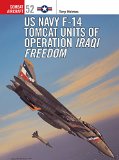
US Navy F-14 Tomcat Units of Operation Iraqi Freedom
Since the limited Desert Fox campaign against Iraq in December 1998, the Tomcat has been integral to virtually all combat operations involving the US Navy in the Arabian Gulf. Indeed, on every carrier deployment to the Persian Gulf since Desert Fox, the F-14 unit(s) on station has ventured into “The Sand Box” over southern Iraq and prosecuted targets operating in contravention to United Nations security council resolutions. This book covers the F-14 Operation Iraqi Freedom actions against battlefield targets and integrated air defense sites, command and control centres, regime leadership targets and military installations in Baghdad, Tikrit, Mosul and Kirkuk.

Tomcat Alley: A Photographic Roll Call of the Grumman F-14 Tomcat
“Tomcat Alley” contains over seven-hundred images depicting the venerable F-14 Tomcat, bureau number by bureau number. Each U.S. Navy Tomcat is traced from date of delivery through February 1998. After a brief introduction, informative captions provide details concerning every Tomcat model, modification, and the fate of each aircraft including those stricken due to operational accidents, retired to the “bone-yard”, or resting as “gate guards” at military installations around the country. The majority of Tomcats are shown in full-color with images displaying every paint scheme worn by the F-14, including many water-based schemes applied during various tactical exercises and deployments. Images also include every squadron commander’s aircraft, nose art, tail colors, over 150 patches and insignia, bicentennial schemes, and Tomcats which participated in Operation Desert Shield/Desert Storm. Additionally, the Su-22, MiG-23, and Hi-8 killers are depicted along with “movie star” Tomcats from “Final Countdown,” “Topgun,” and “Executive Decision.”
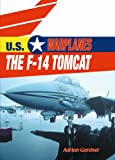
The F-14 Tomcat
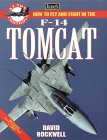
Jane’s How to Fly and Fight in the F-14 Tomcat
Jane’s At the Controls reveals what it is like to fly and fight in the F-14 Tomcat. Tasked with the long range defense of the US Navy’s carrier task forces, the F-14 is now taking on new roles. On the hypothetical mission, set in the near future, you follow a flight of F-14’s through all phases of an operation.
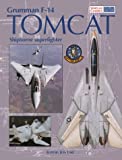
Grumman F-14 Tomcat: Shipborne Superfighter
This is THE book for Grumman’s venerable F-14 Tomcat. Sure, some other books like Tomcat Alley by David F. Brown might beat it in the pictorial department, but overall the information in the articles plus the photos it already has beat any other book about the F-14 Tomcat. Everything about the Tomcat until the books date of publication is covered. From the early beginnings of the Navy’s need for a Fleet Air Defense F6D Missileer and the VFX competition that Grumman won all the way to the combat record and current strike attack roles. Every F-14 variant is covered, even the ones that were only concept models. Plus great artistic renderings of historic F-14’s. A lot of the articles here came from World Air Power Journal’s F-14 cover issue back in the early 90s, but the information here is updated such as the squadron deployments, squadron disestablishments and the wars in Eastern Europe. All F-14 Squadrons in the US Navy are covered, and even some stuff about the IIAF/IRIAF F-14’s. If all that isn’t enough, there’s a foreword by F-14 Tomcat pilot D. Stuart Broce, the VF-1 pilot who shot down a Mi-8 helicopter during Desert Storm. It’s very interesting and heart warming to read.
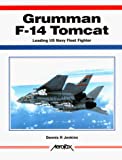
Grumman F-14 Tomcat: Leading Us Navy Fleet Fighter
This addition to the Aerofax series describes all the variants, including the so-called “Bombcat” attack version and the extremely capable F-14D. It covers color schemes, squadrons and markings, and aircraft production details. Lavishly illustrated, it includes close-up details of cockpits and weaponry, giving modelers and enthusiasts superb access to one of the classic jet fighters of all time.
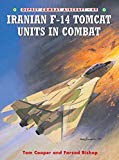
Iranian F-14 Tomcat Units In Combat
So formidable an opponent did the Iraqi airforce consider the F-14 that during the Iran-Iraq war, they ordered their pilots not to engage F-14’s and the presence of one in an area was usually enough to empty it of Iraqi aircraft. Officially losses where tiny; only one F-14 was lost in aerial combat (to a MiG-21), one to a control problem and one downed by a ground-to-air missile. This book looks at the F-14’s Iranian combat history and includes first hand accounts from the pilots themselves. It will consider key engagements and the central figures involved, illustrating the realities, successes and failures of the Iranian air campaign.
